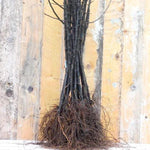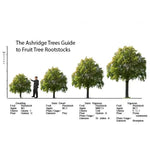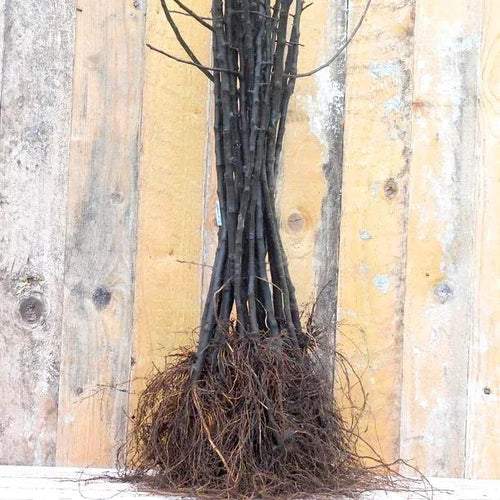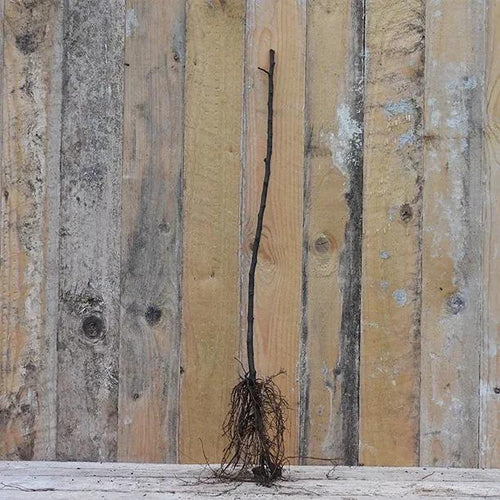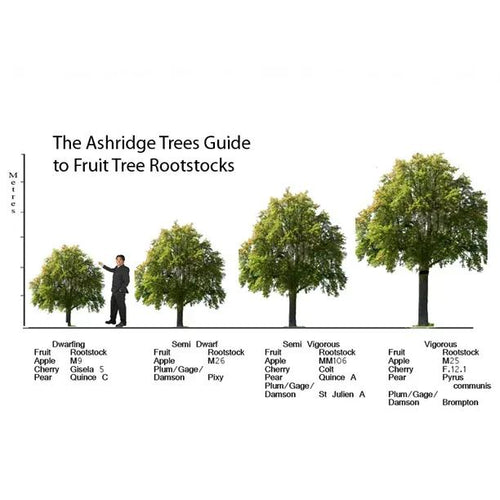Rootstocks for Apple Trees
The rootstock of your fruit tree controls its final size. When buying any fruit tree from us, you do not need to worry about choosing the right rootstock: they're grown on the most suitable one for its intended final shape and size. Each tree's page will say which rootstock it's grown on: we use MM106 for almost all the apple trees. It works for both trained shapes like fans or espaliers and can also produce a mature tree that is a manageable size for a garden. Some of our vigorous trees need to be grown on M9 when they're sold as cordons, and some of our cider apple trees are grown on M25 to give you the biggest possible crop.
Rootstocks will be despatched in February and March.
Browse our other rootstocks, our range of apple trees or the full variety of fruit trees.
For grafting your own apples, you can buy five apple rootstock sizes: M27 (very dwarfing), M9 (dwarfing), M26 (semi-dwarfing), MM106 (semi-vigorous or "normal") and M25 (vigorous, which produces the largest apples trees).
There are many expert books out there on grafting.
In summary, you plant your rootstock in the winter and let it establish through early spring.
You can graft onto it in various ways when it's growing away in April or May.
Apple Rootstocks at a glance:
| Rootstock Name | Size Range & Max. Mature Height | Common uses |
| M27 | Very Dwarfing (2 metres) | Rarely used. Pots or Cordons. Requires support. |
| M9 | Dwarfing (2.5 metres) | Cordons. Requires support. but always grown against a wall or the like |
| M26 | Semi-Dwarfing (3.5 metres) | Bushes. Requires support in windy conditions |
| MM106 | Semi-Vigorous (4 metres) | All purpose - can even be used for cordons. Needs no support when established. |
| M25 | Vigorous (6-7 metres) | Cider apple trees & commercial growing. Picking-crane required for harvest and spraying. Needs no support when established. |
Features
M27 is the least vigorous rootstock, producing a tree that will struggle to reach 2 metres (6 feet).
Its major shortcoming is that growing conditions have to be ideal and even then your crop will be small.
It's rarely used, and we do not grow any trees on it.
M9 is a dwarfing rootstock, producing a tree about 2-2.5m (7-8ft), which is ideal for cordon apples.
Soil preparation is very important - M9 has shallow, weak roots that need rich soil to get what they need. They're also not strong enough to compete with grass & weeds and will always need watering in dry weather.
M9 trees need permanent support if you want to grow them as a small bush (cordons are wire-trained).
M26 is a semi dwarfing rootstock, producing a tree 2.5-3.5m (8-10ft) at maturity. The size is suited to smaller gardens, but like M9, the M26 rootstocks do not have a strong root system and require permanent support.
We think that M9 is best for cordons, while MM106 is better for any larger sizes.
MM106 is an all-purpose rootstock that is used by both gardeners and commercial orchards, producing a free-standing tree around 4m (12ft), which can easily be kept a smaller size of about 2.5 metres with a good pruning regime. It's also great for wall trained fans and espaliers.
After your trees are established, they don't need support.
We grow most of our apple trees on MM106.
M25 is the classic rootstock of the cider apple orchard, where the biggest crops are needed to get loads of juice. It's too large for most people's gardens, producing a freestanding tree that can be 6-7 metres (20 feet plus) in height.
We grow a few cider apples on M25, but you must have access to a proper cherry picker and commercial grade spraying equipment when they're mature - using a ladder is simply too dangerous for you and is likely to damage the tree too.
Our Guarantee applies only to the rootstock:
Please note that our survival guarantee only covers the rootstock if it dies before grafting. It doesn't cover the graft itself.
If you aren't familiar with grafting but want to give it a try, may we recommend some videos by Stephen Hayes. You should watch his work on collecting scion wood and then an excellent video on different grafting techniques; also highly recommended is the YouTuber Skillcult, who expands on the basic grafting techniques into more advanced territory.








 Secure, One-Tap Checkout
Secure, One-Tap Checkout
 Hand Picked, Delivered to Your Door!
Hand Picked, Delivered to Your Door! 1 Year Bareroot Guarantee
1 Year Bareroot Guarantee